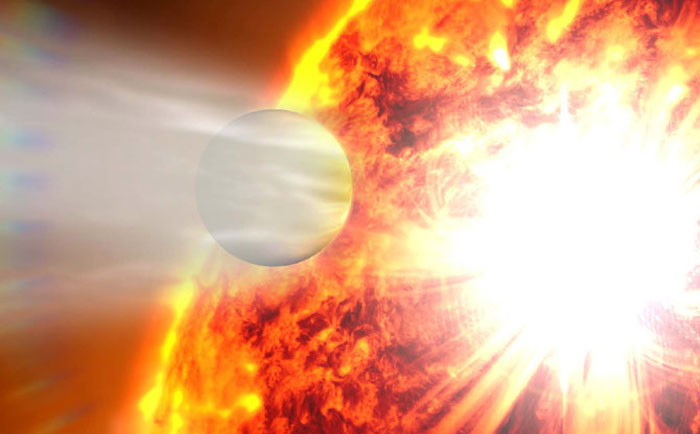.

Scientists using the Hubble Space Telescope were thrilled to catch a view of the Jupiter-sized exoplanet HD 209454b as it passed across the face of its parent star, relative to the observatory’s line of sight.
But what they found left them puzzled: a strange, asymmetrical pattern of highly charged hydrogen atoms moving quickly away from the star.
With the help of a new three-dimensional computer model, they now have an explanation. The model, which takes into account all known interactions between stellar winds and planetary atmospheres, indicates that the mysterious hydrogen flow is a telltale sign of the planet being bathed in stellar winds from its parent star that reached 249 mile-per-second during the transit.
The model also shows that the planet’s magnetic field was about 10 percent as powerful as Jupiter’s at the time.
The new model, reported in this week’s Science, is expected to become a useful tool for assessing how planets beyond the solar system are interacting with their host stars.
Quelle: D-News
.
Unlocking the Secrets of an Alien World's Magnetic Field
.
The strength of an alien world's magnetic field may have been deduced for the first time, by analyzing extraordinarily fast winds slamming against it from the planet's star, researchers say.
This research could help gauge the strength of other exoplanets' magnetic fields as well, scientists say.
The magnetic field of a planet can influence its evolution in crucial ways. "It works as a shield against stellar wind particles, which erode the atmosphere, so it is important to know if this field is big or small," said study lead author Kristina Kislyakova, a planetary scientist at the Austrian Academy of Sciences, in Graz.
In order to find out magnetic details about exoplanets — planets beyond our own solar system — Kislyakova and her colleagues investigated HD 209458b, which orbits a sunlike star in the constellation Pegasus about 150 light-years from Earth. This alien world is only about 70 percent the mass of Jupiter, but nearly 40 percent wider.
HD 209458b is a "hot Jupiter," a gas giant that orbits its star closer than Mercury does to the sun — specifically, HD 209458b circles its star at a distance of less than one-twentieth the distance between the sun and Earth. The extraordinary roasting that HD 209458b endures makes its atmosphere blow away like the tail of a comet. Astronomers have informally dubbed the world "Osiris," after the Egyptian god torn to pieces by his evil brother Set.
The researchers used NASA's Hubble Space Telescope to analyze the spectrum of light from HD 209458b as it passed in front of its star. Oddly, the data revealed hydrogen atoms moving away extremely quickly from the exoplanet in a lopsided manner.
To help explain the unusual way in which the hydrogen is blowing off HD 209458b, the scientists built a 3D model to account for all the known interactions between planetary atmospheres and stellar winds, the flow of particles that stream off stars. The model suggested the exoplanet had a magnetic field about 10 percent as strong as Jupiter's, and that the stellar wind blowing onto the planet was moving at about 895,000 mph (1.44 million km/h).
These findings support prior research suggesting that hot Jupiters have relatively weak magnetic fields compared with their cooler gas giant cousins. Since hot Jupiters orbit very near their stars, they experience powerful gravitational pulls that likely slow the rates at which these hot Jupiters spin. This slower rotation should result in weaker magnetic fields, because a planet's magnetic field "is generated most effectively in fast-rotating cores of planets," Kislyakova said.
The scientists detailed their findings online today (Nov. 20) in the journal Science.
Quelle:SC
4738 Views
